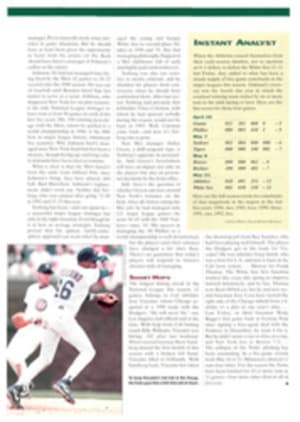
Colossus of the Columbia
On a leader as light as Gossamer, the sporting fly-fisherman can make a worthy opponent of a five-inch trout. Working streams small enough to leap across, I have battled for a quarter of an hour or more with fish only slightly bigger than aquarium guppies. I've brought these prizes home to the amusement of the uninitiated in my family, who contend that the point of the sport is the Biggest Fish Ever, not my paltry fingerlings. And what can I say in response? After being subjected to this sort of duress, I felt a mid-fishing-life crisis creep over me last year, and I began to worry that my three sons and my wife, Robin, were right about everything. And that I was wrong. So in March I went fishing for Moby Dick to test the Big Fish proposition. Might bigger be better, after all?
The sturgeon—the white sturgeon, Acipenser transmontanus, one of the largest freshwater fish in North America—can grow as long as 20 feet and as old as a hundred years and weigh as much as 1,800 pounds. When you bring one home, there is nothing to explain to those who only understand big. They stand agog, like the tourist on the terrace at the end of The Old Man and the Sea, and stare in disgust and admiration at the monstrous thing you have brought up from the bottom of a river. Later they will want to eat it.
Sturgeon is good in a butter sauce with Dijon mustard, fresh basil and cracked black peppercorns, the way it is served at Jake's Famous Crawfish Restaurant in downtown Portland, Ore. And, at roughly $25 a spoonful, its caviar is equally delicious. To some, anyway.
I go fishing on a Sunday, in a moderate rain, with a big man named Gary Krum. Krum, the acknowledged king of sturgeon guides, has hauled his five-person jet sled from Bay City on the Oregon Coast to a put-in near the mouth of the Columbia River, which divides Oregon and Washington. It was in these same roiling waters—four miles across and carrying most of the Pacific Northwest's drainage to the ocean—that ship after ship foundered during the age of European exploration. Legend has it that the remains of the shipwrecked sailors were devoured by fearful-looking sea monsters; sometimes these huge beasts were seen tailing gleefully along the water's surface.
Fog shrouds both banks in the early morning light as Krum and three other anglers and I set out into the gray waters at the mouth of the Columbia. The rain comes down steadily, a stiff northerly is blowing, and the river runs heavy with white chop. In the immense body of estuarine water, Krum searches for a hole the size of my living room: a drop-off where the current comes boiling over a ledge, then sinks and furls back under itself, a backwash 80 feet down. In such places the sturgeons hold off the bottom, feeding leisurely on whatever the river brings their way, which at this time of year, Krum says, is spawned-out, dying smelt. Sturgeon are said to eat whatever they can smell: hogs' heads, dead cats, a bushel of onions in a burlap bag, a leaky can of baked beans. Because of this many fishermen spray their bait with WD-40, the scent of which attracts sturgeon, before offering it to the river's bottom.
Sturgeon are famous for being hideous, and there are many people who suffer from the disturbing memory of their first glimpse of one. It is a fish that has been on this planet for more than 200 million years. With its five rows of diamond-shaped bony plates, or scutes, a sturgeon is vaguely reminiscent of the stegosaurus depicted in children's books. Humans might feel an affinity for the salmon, all sleek and silvery and eager to spawn, but sturgeon inspire the kind of revulsion generally reserved for banana slugs. They have antennae, four barbels on their rock-hard snouts, which they use to explore a river's muck. Like sharks, they have no bones, only cartilage. They eat without discrimination, everything from worms to lamprey eels. Perhaps most disconcerting is the sturgeon's mouth, an obscene, toothless round tunnel that depends mudward from the fish's underside. It is easy to be taken aback by this hoselike maw, which has the profile of a giant tubeworm. A sturgeon could star in its own horror movie.
In spite of the fish's appearance, or perhaps because of it—and because its flesh is succulent enough to be served as a delicacy in fine restaurants—there are anglers who are obsessed with sturgeon. Like Ahab, they think of nothing else, and on weekends can be found fishing shoulder to shoulder in the tail-out below the Columbia's Bonneville Dam. These fishermen cast with the graceful power of discus throwers, heaving their bait—pickled herring or shrimp—far out into the river. Their rod holders are made of PVC pipe and duct tape. They hunker beside fires beneath tattered tarpaulin lean-tos, their backs to the wind, damp cigarettes between their lips, jars of peanut butter and loaves of Wonder bread tucked up under their rain gear.
Tony Chea, 24, has been angling here for a decade; from Aloha, near Portland, he wears a pair of hoop earrings in the lobe of his left ear and fishes with a 16-foot rod. "Why sturgeon?" he says. "Because they fight so hard. Three-and-a-half hours—they fight that long. They fight you smart, too."
Now, fishing on the river with Krum, I think of Chea's reply and of photos in the Oregon Historical Society Museum in Portland that show a teenager in overalls and rubber boots with a 700-pounder winched up beside him; another youth standing on a tall man's shoulders, his arm extended upward to reach the head of a hanging sturgeon; a crowd of men in suits and hats, posing grimly beside an 11-footer caught in 1916.
The sturgeon I caught that day put up a fight for all of 10 minutes. And the other anglers on board Krum's jet sled—a librarian, an 11-year-old boy and a high school English teacher—each caught one too.
"He's not that big," Krum points out when I haul my sturgeon on board. "You're just used to your puny little trout."
Three feet, four inches long, a keeper, if not exactly Moby Dick. It is the biggest fish I have ever caught, though, big enough to photograph twice, from different angles, big enough to bring home jauntily, with manly vigor, big enough to slap down on the kitchen counter. It's so big that there's nothing to explain to anyone; this fish speaks for itself.
"But the trout are cuter," my wife says, standing back from the thing. "This fish is big, but it's ugly."
"You can't have everything," I reply.
My sons, however, are profoundly impressed by the size of my sturgeon and tell me that in the distant days of their manhood they intend to catch one too. "Bigger than yours," adds one of them. And so the rod will be passed to a new generation of Ahabs troubled by Big Fish Fever. I tell them that a huge, ugly sturgeon on the end of one's line is probably the only real cure for the affliction.
TWO PHOTOS
HARLEY SOLTES
A sturgeon uses its barbels to explore the river bottom; fisher haul out a seven-footer.
PHOTO
OREGON HISTORICAL SOCIETY
This 11½-foot, 900-pounder, caught in the Columbia in 1951, was 82 years old.
David Guterson, who lives in Bainbridge Island, Wash., has written a number of stories for SI.

